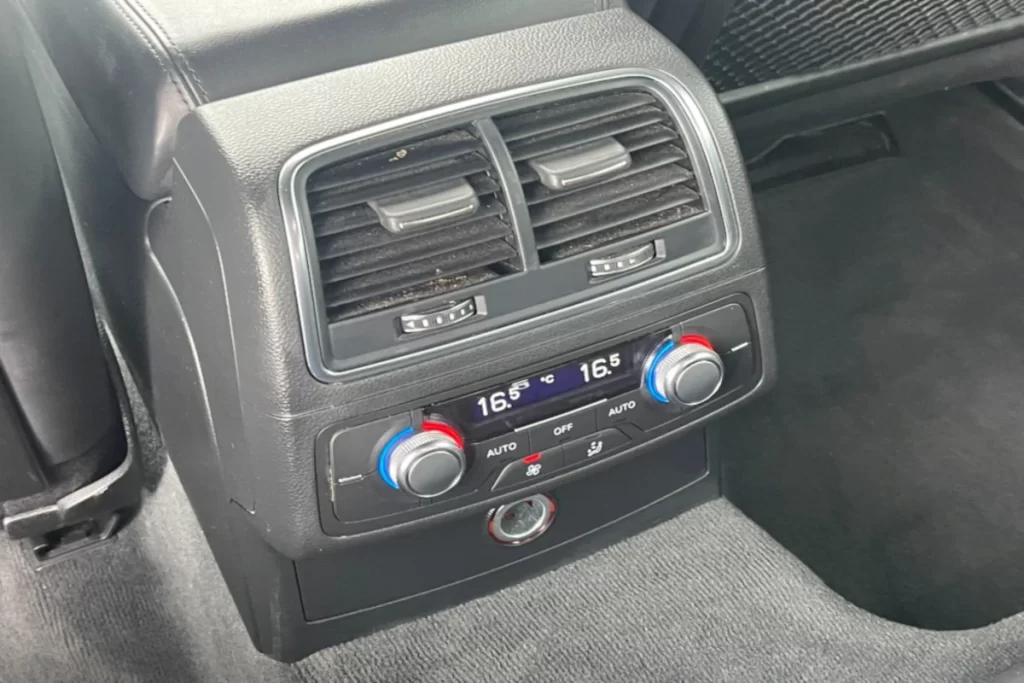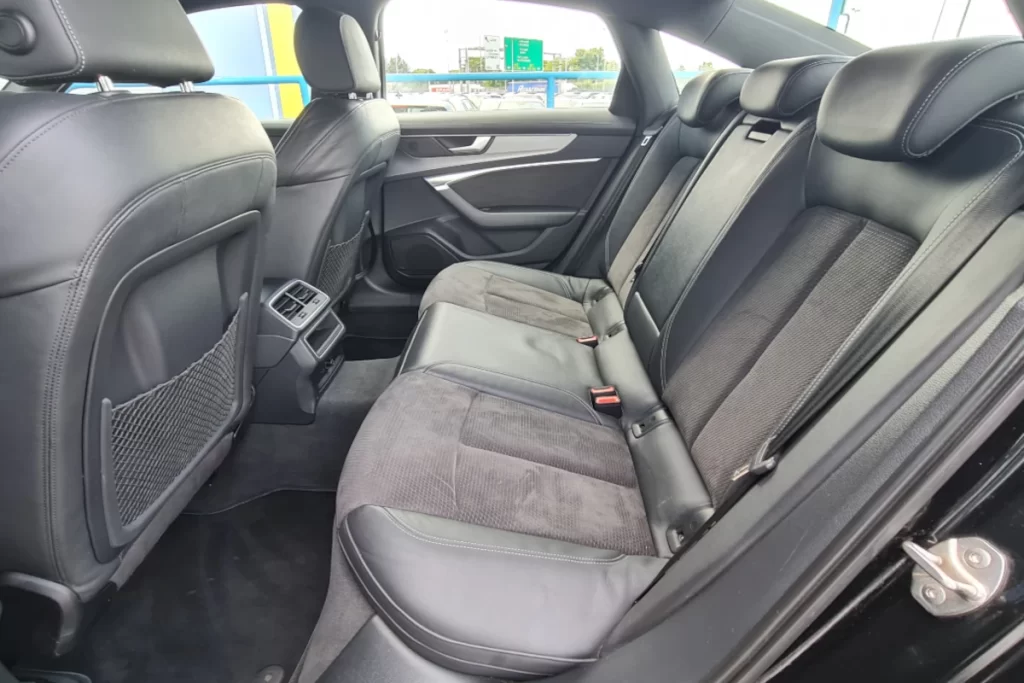The rear A/C vent is an additional A/C ventilation system in the back of the vehicle, designed to increase air circulation.
Do these additional A/C vents increase fuel demand? Can you install them in your car by yourself?
To learn all these things and more, keep reading!
Here’s What A Rear A/C Vent In a Car Is
The air conditioning (A/C) vent in the rear of the car is an additional vent in the back of the vehicle. These vents are meant to enhance the comfort and enjoyment of the vehicle for all passengers. These vents are handy for large cars where the cold air doesn’t get trapped before cooling the back of the vehicle.

Air conditioners were introduced inside cars in 1939 and used to cool and heat vehicles. However, these early models were bulky, heavy, and very expensive.
Most estimates say these early units cost $275.00 to install (which is over $5,000.00 today). Bishop & Babcock Company filed for a patent for this machine in 1937 but could not get the size and cost down. This machine was discontinued in vehicles in 1941 and wasn’t seen again until the mid-1990s and early 2000s.
As air conditioning became the norm at the turn of the 21st century, the demand for extra features increased. With this increased demand came an increased desire for comfort inside vehicles at all times of the year, no matter where you sit.
It used to be the norm that whoever sat closer to the front seat would be the coolest. However, the introduction of the rear a/c vents helps make the whole car climate controlled.
Also, the vehicle can cool off quickly with the introduction of rear vents!
Related:
- What Is Dual Climate Control In A Car? (Explained For Beginners)
- Is It Bad To Run AC In Idle? (Might Surprise You)
- What Does Car A/C Button Do When Heater Is On? (Explained)
How Do Rear A/C Vents Actually Work?

Rear A/C vents are connected to the car’s primary climate control system. When the user engages the rear vents, it propels energy to channel the air toward the back of the vehicle. However, the presence of the rear vents makes this movement more direct and efficient.
Most modern cars have an efficient A/C system. However, because a rear vent requires more energy to propel the air, it can induce a more significant drain on fuel.
This is because the function of the climate control system is to move air into the cabin. When this air is pushed further back, it requires more force and power. This is especially true if you install a rear A/C ventilation system yourself.
The A/C system in a car works by pressing warm air through the refrigerant system. This system is filled with freon gas, which artificially lowers the temperature of the air.
It removes humidity from the air. This allows dry, cool air to enter the car cabin.
The rear A/C system is an additional ventilation system. It’s not a separate A/C system.
What Are The Benefits of Rear A/C Vents?
The primary purpose and benefit of the rear A/C vents are to allow people in the back to feel comfortable. These vents help promote an equal distribution of cool air and prevent one section from receiving the bulk of the cool air. No area gets too much cold air, while the back section gets very little.
The essential benefit of rear A/C vents is evenly distributing and sharing the cool air from the climate controls. This might be unnecessary for small vehicles, but it’s beneficial for large trucks, SUVs, and buses.
The alternative in large vehicles is to have the A/C turned on high. This wastes significant power and fuel while making certain passengers colder than they’d like.
For a single ventilation system to effectively cool the entire car space, it must be turned on high.
This allows everyone to have the desired temperature without freezing the front passengers.
These systems can be regulated and monitored individually. However, having a rear ventilation system distributes the cool air evenly. This means people in the back of the car can have the A/C on while the front has their vents turned off.
How Do You Know If Your Car Has Rear A/C Vents?

Rear ventilation systems present themselves with the presence of vents throughout the vehicle. This is the most obvious indication that your vehicle has a rear A/C unit. Additionally, check with the manufacturer’s manual or website to verify your car has a rear A/C system.
In smaller vehicles, the vents are usually on the back of the center console. These vents bring cool air from the front A/C system to the back seats of the car.
If you see these vents, your car A/C unit has rear ventilation.
However, these vents are usually elsewhere in larger cars such as SUVs or Econoline vans. You can typically find ventilation systems on the doors of an SUV. These are conveniently located to spread cool air directly on the rear passengers.
Econoline vans have a lot more space to cool. That’s why the A/C vents are usually found on the van’s ceiling. Each row can easily open and close these vents, allowing the passenger to monitor how much air they receive.
Why Don’t All Cars Have Rear A/C Vents?
Not all cars have rear A/C vents because of their size and potential occupancy. Small vehicles are the least likely to have rear vents in addition to the front A/C controls. This is because small cars don’t typically transport more than 1-2 people, making the vents redundant.
Not all cars have rear A/C ventilation because they’re not necessary. A vehicle’s A/C system can increase fuel consumption by up to 20%. Adding the additional need to power this cool air to the back of the car and fuel consumption rises further.
Therefore, these vents are only added to vehicles when necessary.
In large vehicles, these vents are necessary. Without them, the back row of seats will receive little to no ventilation. The only way to cool these rear seats is to turn the A/C system on high, which is a waste of power.
Finally, the maximum occupancy of most small cars is 4-5 people (if they squish into the middle seat). Studies out of Germany indicate that most small cars carry under two passengers daily. This suggests that small vehicles don’t need extra vents because it’s unlikely they’ll have backseat passengers.
Which Cars Have Rear A/C Vents?
Large vehicles such as SUVs, vans, and buses are the most common types to have rear A/C vents. This is due to the large space that needs to be cooled and requires several ventilation points. Small vehicles don’t need extra vents to properly cool all the seating areas.
SUVs are the most popular passenger vehicles to have rear or multiple-row A/C vents.
Some common brands and models include the following:
All of these cars have something in common: they all have more than two rows of seating. With three or more rows of seating, it indicates these cars cater to large families or large groups of people.
Unlike small cars which statistically only carry 1-2 people, these large cars carry more than 4 on a regular basis.
Conclusion
Rear air conditioning vents are useful in large cars that carry numerous passengers. They’re convenient and add a level of comfort unavailable in the past. This makes them a useful and preferable feature in modern large vehicles, such as SUVs.
However, they’re unnecessary for small cars such as sedans. Even though some creative people install these units themselves, this might not be a great idea. These additional vents demand a lot of power from the engine, especially if not maximized for power consumption.
Sources
Wikipedia: Automobile air conditioning
National Museum of American History: Trade catalogs from Bishop & Babcock Mfg. Co.



